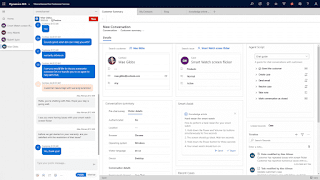Dynamics AX vs Dynamics 365 F&O: Comparing Microsoft's Enterprise Resource Planning Solutions
In the realm of enterprise resource planning (ERP) solutions, Microsoft has established a strong presence with its offerings, including Dynamics AX and Dynamics 365 Finance and Operations (F&O). These two platforms have gained popularity among businesses seeking comprehensive ERP capabilities. In this article, we will explore the similarities, differences, and key features of Dynamics AX and Dynamics 365 F&O, enabling you to make an informed decision when selecting the right solution for your organization.
Dynamics AX, previously known as Axapta, has a long-standing history as a robust ERP system. It has proven its worth in industries such as manufacturing, distribution, and retail. On the other hand, Dynamics 365 F&O is the successor to Dynamics AX and is built on the latest cloud-based architecture, delivering enhanced scalability, flexibility, and integration capabilities. Let's dive deeper into their features and functionalities to understand the distinctions between the two solutions.
One of the primary differences lies in the deployment options. Dynamics AX is an on-premises solution, whereas Dynamics 365 F&O is a cloud-based offering. While Dynamics AX provides complete control over infrastructure and data, Dynamics 365 F&O offers the advantages of automatic updates, scalability, and accessibility from anywhere with an internet connection. The cloud-based nature of Dynamics 365 F&O ensures that organizations can stay up to date with the latest features and enhancements without the need for extensive IT resources.
Both platforms offer similar core functionalities, including financial management, supply chain management, manufacturing, and human resource management. However, Dynamics 365 F&O introduces some new features, such as embedded Power BI analytics, improved integration with Microsoft's Power Platform, and advanced warehouse and transportation management capabilities. These additions provide users with enhanced insights, automation, and collaboration, making it easier to drive business growth and streamline operations.
In terms of user experience, Dynamics 365 F&O boasts a modern, browser-based interface that is intuitive and easy to navigate. It embraces a role-based approach, enabling users to personalize their dashboards and access relevant information quickly. Dynamics AX, while not as visually appealing as its successor, still provides a robust user interface with comprehensive functionality. The choice between the two largely depends on the preferences of your organization and users.
Another critical aspect to consider is the pricing model. Dynamics AX follows a traditional perpetual licensing model, where organizations pay an upfront fee for the software licenses. On the other hand, Dynamics 365 F&O is based on a subscription model, where businesses pay a recurring fee based on user counts and usage. The subscription-based approach provides organizations with more flexibility in scaling their ERP solution as their business grows and evolves.
Integration capabilities play a significant role in today's interconnected business landscape. Dynamics 365 F&O offers seamless integration with other Microsoft products and services, such as Office 365, Power Platform, and Azure. This integration empowers organizations to leverage a unified ecosystem, enabling data and process flow across various applications. While Dynamics AX also provides integration capabilities, the level of integration and interoperability offered by Dynamics 365 F&O is more extensive and streamlined.
Lastly, it is essential to consider the long-term roadmap and support for each solution. Microsoft is committed to providing support and updates for Dynamics AX until October 2028. However, as the newer offering, Dynamics 365 F&O receives ongoing updates, improvements, and innovations from Microsoft, ensuring that organizations benefit from the latest technologies and functionalities.
In conclusion, both Dynamics AX and Dynamics 365 F&O are powerful ERP solutions with their own strengths. Dynamics AX Upgrade partner caters to organizations that prefer an on-premises deployment and desire complete control over their infrastructure. On the other hand, Dynamics 365 F&O offers the advantages of cloud-based deployment, automatic updates, and enhanced integration capabilities.
When choosing between the two, consider factors such as deployment preferences, scalability needs, user experience, integration requirements, and long-term support. Dynamics 365 F&O excels in terms of cloud scalability, modern user interface, and extensive integration options with other Microsoft products. Dynamics AX, on the other hand, provides a robust and comprehensive ERP solution for organizations that prefer on-premises deployment and have specific control requirements.
Ultimately, the choice depends on your organization's specific needs, preferences, and future growth plans. It is recommended to evaluate the features, functionalities, and pricing models of both solutions to determine which one aligns best with your business objectives.
READ MORE:
AI in Microsoft Dynamics 365 Customer Service: Revolutionizing Customer Support and Experience
How to Boost Customer Engagement With Dynamics 365: Strategies for Success




Comments
Post a Comment